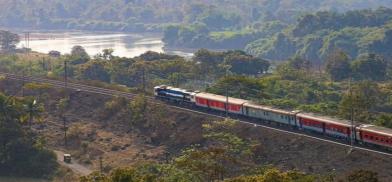Boosting rail connectivity between India and Bangladesh is a win-win for both
While air remains a major mode of transportation for tourists—almost 77 percent, around 80 percent of Bangladeshi tourists used the land as the mode of transportation. Thus, an integrated, cross-border railway network as a faster mode of transport could bring enormous benefits to the region, including boosting regional trade.

On Wednesday, India and Bangladesh jointly flagged off a new passenger train, Mitali Express, a bi-weekly train connecting New Jalpaiguri in North Bengal with Dhaka, the Bangladesh capital. The new train, which will cover a distance of 513 km in 9-10 hours, will not only boost connectivity and tourism between the two South Asian nations but also ease transit to landlocked Nepal and Bhutan via Bangladesh.
With this train, the total number of passenger rail routes between the two neighbors has reached three, as the two existing ones— the Kolkata-Dhaka-Kolkata Maitree Express, five days a week, and Kolkata-Khulna-Kolkata Bandhan Express, bi-weekly—was resumed recently.
Bangladesh media reports say that Dhaka is hoping that India will increase the frequency of these trains which will further boost people-to-people connections.
Given that the two countries share a 4096 km long boundary and multiple land routes for land crossing, the number of train routes— a relatively faster and cheaper mode of transportation—still remains much below their real potential.
Boost to tourism and cultural linkages
That Bangladesh happens to be the topmost source market of foreign tourists in India—one of the most underappreciated and often ignored aspects of bilateral ties—provides the even greater imperative to boost rail connectivity.
In 2019, over 2.5 million Bangladeshi tourists traveled to India - accounting for almost 23 percent of total foreign tourists in India—contrary to the popular perception of them being mostly "illegal immigrants". This is as pero data provided by India’s Ministry of Tourism.
While air remains a major mode of transportation for tourists—almost 77 percent, around 80 percent of Bangladeshi tourists used the land as the mode of transportation. Thus, an integrated, cross-border railway network as a faster mode of transport could bring enormous benefits to the region, including boosting regional trade.
C Raja Mohan, a noted Indian strategic expert, in a recent column in The Indian Express wrote, “Developing all religious pilgrimage sites across the region and improving the transborder access to them could not only improve the tourist revenues of all South countries but could also have a calming effect on the troubled political relations between the nations.”
Tapping trade potential
Recently released trade data showed India exported goods and services worth around $16 billion to Bangladesh, making it India’s fourth-largest export destination, with overall bilateral trade crossing $18 billion, an increase of 76 percent and 67 percent from the fiscal year 2018-2019 and 2020-21 respectively.
So far, five railway border crossings have been rebooted and efforts are on to strengthen more freight trains. This will enable faster and cheaper movement of goods and cargo, thus helping reduce dependency on road and sea routes.
Last year’s World Bank report estimated that seamless connectivity between the two countries could increase the national income of Bangladesh by 17 percent and that of India by 8 percent.
'Logic of geography'
Underpinning the geographical imperative that binds India to its neighbors, Raja Mohan said that recent crises in the region and the world, “should remind the region’s leaders that working with the logic of geography has become an unavoidable necessity..."
The greater cross-border linkages and economic interdependence will not only help us overcome mutual distrust but will also enable us to handle complex challenges with relatively more maturity.
India’s muted response—and even refusal to use the word “concern” in its statements— during the last year’s widespread anti-Hindu violence in Bangladesh and Dhaka’s measured responses to anti-Muslim incidents in India, despite domestic pressure in their respective countries, are outcomes of mutual desire not to let these 'aberrations' stand in the way of the rapid progression in bilateral ties for the overall benefit of the people of the two countres, and the BBIN (Bangladesh, Bhutan, India and Nepal) sub-regional grouping that India is seeking to encourage since the larger SAARC grouping is going nowhere.
(The author is Research Associate, Society for Policy Studies. Views are personal)









Post a Comment